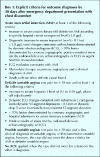Safety and efficiency of emergency department assessment of chest discomfort
- PMID: 15184334
- PMCID: PMC419767
- DOI: 10.1503/cmaj.1031315
Safety and efficiency of emergency department assessment of chest discomfort
Abstract
Background: Most Canadian emergency departments use an unstructured, individualized approach to patients with chest pain, without data to support the safety and efficiency of this practice. We sought to determine the proportions of patients with chest discomfort in emergency departments who either had acute coronary syndrome (ACS) and were inappropriately discharged from the emergency department or did not have ACS and were held for investigation.
Methods: Consecutive consenting patients aged 25 years or older presenting with chest discomfort to 2 urban tertiary care emergency departments between June 2000 and April 2001 were prospectively enrolled unless they had a terminal illness, an obvious traumatic cause, a radiographically identifiable cause, severe communication problems or no fixed address in British Columbia or they would not be available for follow-up by telephone. At 30 days we assigned predefined explicit outcome diagnoses: definite ACS (acute myocardial infarction [AMI] or definite unstable angina) or no ACS.
Results: Of 1819 patients, 241 (13.2%) were assigned a 30-day diagnosis of AMI and 157 (8.6%), definite unstable angina. Of these 398 patients, 21 (5.3%) were discharged from the emergency department without a diagnosis of ACS and without plans for further investigation. The clinical sensitivity for detecting ACS was 94.7% (95% confidence interval [CI] 92.5%- 96.9%) and the specificity 73.8% (95% CI 71.5%- 76.0%). Of the patients without ACS or an adverse event, 71.1% were admitted to hospital or held in the emergency department for more than 3 hours.
Interpretation: The current individualized approach to evaluation and disposition of patients with chest discomfort in 2 Canadian tertiary care emergency departments misses 5.3% of cases of ACS while consuming considerable health care resources for patients without coronary disease. Opportunities exist to improve both safety and efficiency.
Figures
Comment in
-
Acute coronary syndromes.CMAJ. 2004 Nov 23;171(11):1322; author reply 1322-3. doi: 10.1503/cmaj.1041116. CMAJ. 2004. PMID: 15557567 Free PMC article. No abstract available.
-
Acute coronary syndromes.CMAJ. 2004 Nov 23;171(11):1322; author reply 1322-3. doi: 10.1503/cmaj.1041202. CMAJ. 2004. PMID: 15557568 Free PMC article. No abstract available.
References
-
- Heart and Stroke Foundation of Canada. The changing face of heart disease and stroke in Canada. Ottawa: The Foundation; 2000.
-
- Gibler WB, Hoekstra JW, Weaver WD, Krucoff MW, Hallstrom AP, Jackson RE, et al. A randomized trial of the effects of early cardiac marker availability on reperfusion therapy in patients with acute myocardial infarction: the Serial Markers in Acute Myocardial Infarction Rapid Treatment Trial. J Am Coll Cardiol 2000;36:1500-6. - PubMed
-
- Zarling EJ, Sexton H, Milnor P. Failure to diagnose acute myocardial infarction: the clinicopathologic experience at a large community hospital. JAMA 1983;250:1177-81. - PubMed
-
- Lee TH, Rouan GW, Weisberg MC, Brand DA, Acampora D, Stasiulewicz C, et al. Clinical characteristics and natural history of patients with acute myocardial infarction sent home from the emergency room. Am J Cardiol 1987; 60: 219-24. - PubMed
-
- McCarthy BD, Beshansky JR, D'Agostino RB, Selker HP. Missed diagnoses of acute myocardial infarction in the emergency department: results from a multicenter study. Ann Emerg Med 1993;22:579-82. - PubMed
Publication types
MeSH terms
LinkOut - more resources
Full Text Sources
Medical
Miscellaneous


